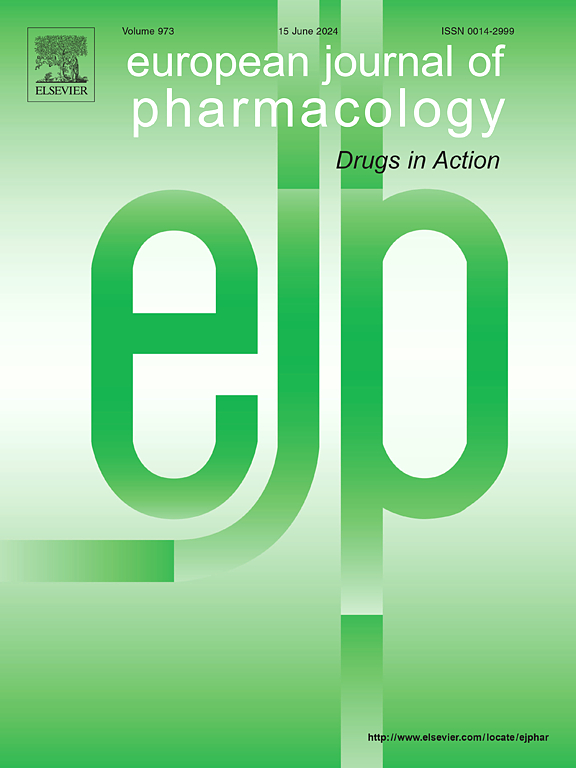青藤碱减轻实验性自身免疫性葡萄膜炎:可能参与PI3K/AKT和NF-κB信号通路
IF 4.2
3区 医学
Q1 PHARMACOLOGY & PHARMACY
引用次数: 0
摘要
葡萄膜炎是一种以自身免疫性病因为特征的眼部炎症性疾病。青藤碱(Sinomenine, SIN)是青藤根茎的主要活性成分。Rehd。会。具有抗炎和免疫抑制的特性。本研究旨在探讨SIN对大鼠实验性自身免疫性葡萄膜炎(EAU)的治疗作用,并阐明其潜在机制。我们进行了生物信息学分析,以确定与葡萄膜炎发病有关的信号通路,从而确定PI3K/AKT和NF-κB通路,以进一步进行实验验证。随后建立EAU模型,用裂隙灯显微镜和苏木精-伊红染色观察眼表形态。免疫荧光法检测蛋白的表达和分布。采用酶联免疫吸附法测定炎症细胞因子的表达。实验结果表明,SIN可显著降低眼部炎症评分。进一步验证表明,SIN显著升高EAU大鼠白细胞介素-10 (IL-10)水平,同时降低IL-17、肿瘤坏死因子-α (TNF-α)和IL-1β水平。SIN显著抑制PI3K/AKT和NF-κB通路磷酸化蛋白的表达。此外,它降低了rorγ - t的表达,同时提高了与Th17细胞和Tregs相关的转录因子Foxp3的表达。综上所述,我们的数据表明,SIN通过抑制PI3K/AKT和NF-κB信号通路的激活以及恢复Th17和Tregs之间的平衡来缓解EAU炎症。这些发现突出了SIN作为治疗葡萄膜炎的一种有前景的治疗药物。本文章由计算机程序翻译,如有差异,请以英文原文为准。
Sinomenine alleviates experimental autoimmune uveitis in rats: Possible involvement of PI3K/AKT and NF-κB signaling pathways
Uveitis is an inflammatory ocular condition characterized by an autoimmune etiology. Sinomenine (SIN), the main active constituent of the rhizome of Sinomenium acutum (Thunb.) Rehd. et Wils., exhibits both anti-inflammatory and immunosuppressive properties. The present study sought to investigate the therapeutic effects of SIN on experimental autoimmune uveitis (EAU) in rats and to elucidate its underlying mechanisms. A bioinformatics analysis was conducted to identify signaling pathways implicated in the pathogenesis of uveitis, leading to the identification of the PI3K/AKT and NF-κB pathways for further experimental validation. An EAU model was subsequently established, and the ocular surface morphology was examined using slit lamp microscopy and hematoxylin-eosin staining. Immunofluorescence was utilized to measure the protein expression and distribution. Enzyme-linked immunosorbent assay was used to determine the expression of inflammatory cytokines. Experimental findings demonstrated that SIN significantly decreased ocular inflammation scores. Further validation revealed that SIN significantly elevated levels of interleukin-10 (IL-10) while reducing levels of IL-17, tumor necrosis factor-α (TNF-α), and IL-1β in EAU rats. SIN significantly suppressed the expression of phosphorylated proteins in the PI3K/AKT and NF-κB pathways. In addition, it reduced the expression of RORγt while enhancing the expression of Foxp3, the transcription factors associated with Th17 cells and Tregs, respectively. In summary, our data demonstrate that SIN alleviates EAU inflammation by inhibiting the activation of the PI3K/AKT and NF-κB signaling pathways and restoring the balance between Th17 and Tregs. These findings highlight SIN as a promising therapeutic agent for the treatment of uveitis.
求助全文
通过发布文献求助,成功后即可免费获取论文全文。
去求助
来源期刊
CiteScore
9.00
自引率
0.00%
发文量
572
审稿时长
34 days
期刊介绍:
The European Journal of Pharmacology publishes research papers covering all aspects of experimental pharmacology with focus on the mechanism of action of structurally identified compounds affecting biological systems.
The scope includes:
Behavioural pharmacology
Neuropharmacology and analgesia
Cardiovascular pharmacology
Pulmonary, gastrointestinal and urogenital pharmacology
Endocrine pharmacology
Immunopharmacology and inflammation
Molecular and cellular pharmacology
Regenerative pharmacology
Biologicals and biotherapeutics
Translational pharmacology
Nutriceutical pharmacology.

 求助内容:
求助内容: 应助结果提醒方式:
应助结果提醒方式:


